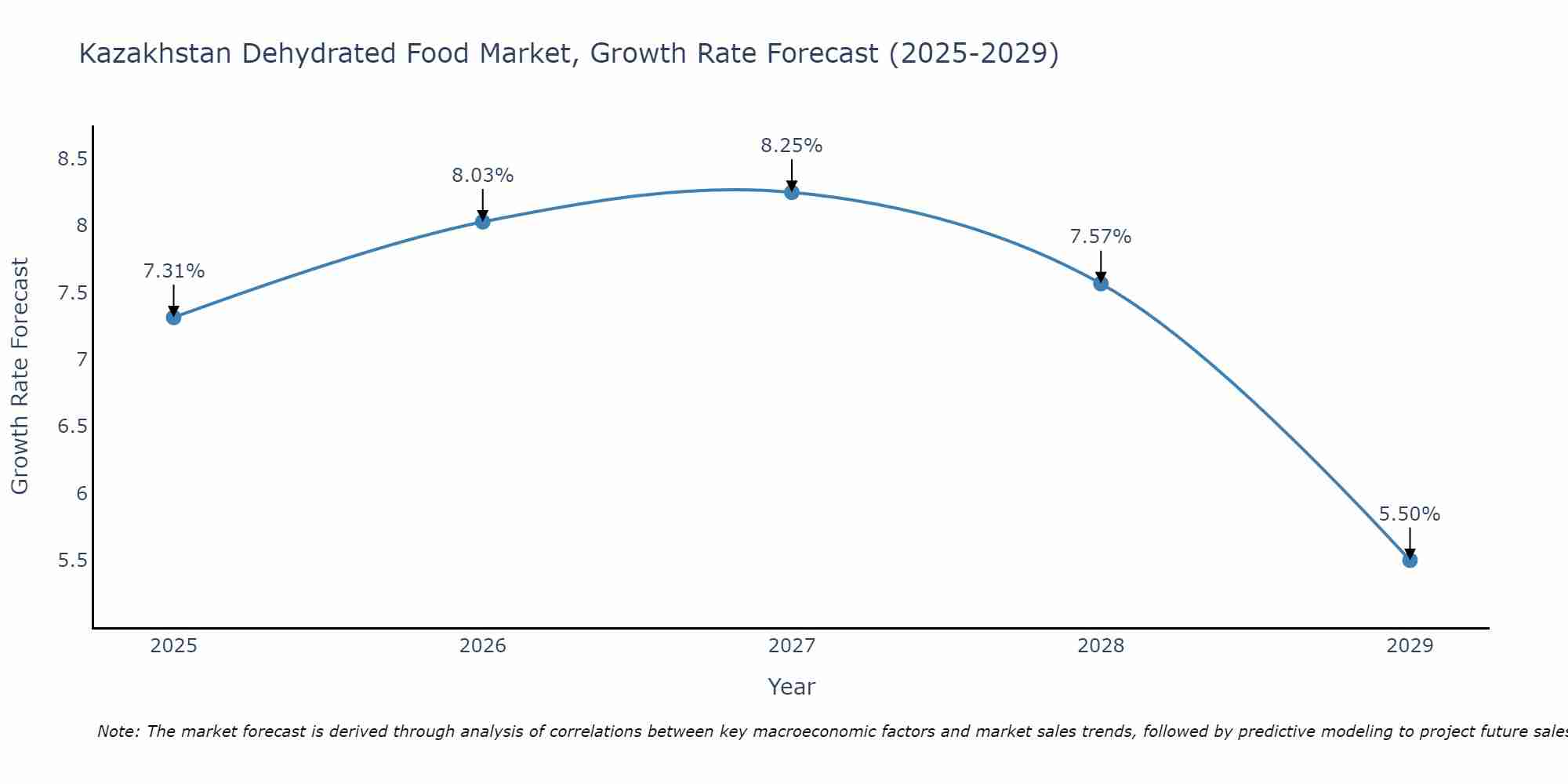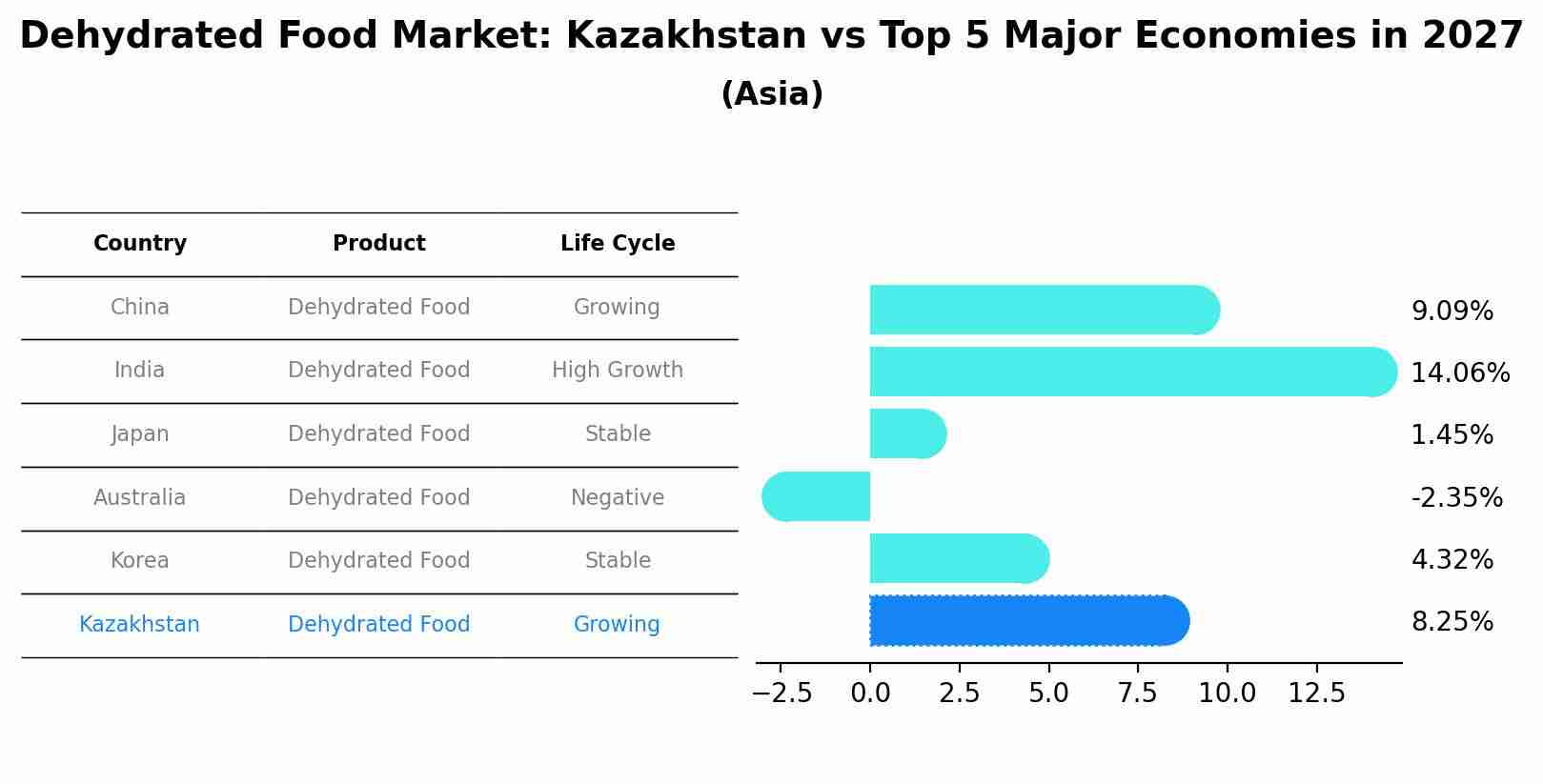Kazakhstan Dehydrated Food Market (2025 - 2031) | Growth, Share, Trends, COVID-19 IMPACT, Analysis, Size, Forecast, Value, Revenue, Companies & Industry
| Product Code: ETC175817 | Publication Date: Jan 2022 | Updated Date: Apr 2025 | Product Type: Market Research Report | |
| Publisher: 6Wresearch | Author: Ravi Bhandari | No. of Pages: 70 | No. of Figures: 35 | No. of Tables: 5 |
Kazakhstan Dehydrated Food Market Size Growth Rate
The Kazakhstan Dehydrated Food Market is projected to witness mixed growth rate patterns during 2025 to 2029. Starting at 7.31% in 2025, the market peaks at 8.25% in 2027, and settles at 5.50% by 2029.

Dehydrated Food Market: Kazakhstan vs Top 5 Major Economies in 2027 (Asia)
By 2027, the Dehydrated Food market in Kazakhstan is anticipated to reach a growth rate of 8.25%, as part of an increasingly competitive Asia region, where China remains at the forefront, supported by India, Japan, Australia and South Korea, driving innovations and market adoption across sectors.

Kazakhstan Dehydrated Food Market Overview
The dehydrated food market in Kazakhstan is experiencing significant growth due to changing consumer preferences, urbanization, and the convenience offered by dehydrated food products. Dehydrated foods have a longer shelf life, retain nutrients, and are easy to store and transport, making them ideal for busy lifestyles. The market is witnessing increasing demand for dehydrated fruits, vegetables, meats, and ready-to-eat meals, driven by factors such as rising disposable incomes and awareness about the benefits of consuming nutritious food.
Drivers of the market
The Kazakhstan Dehydrated Food Market is experiencing significant growth due to several factors. Firstly, the increasing consumer preference for convenience foods, coupled with busy lifestyles, is driving the demand for dehydrated food products. Secondly, the long shelf life and retention of nutritional value in dehydrated foods make them appealing to consumers seeking healthier options. Furthermore, the growing awareness about food preservation techniques and the need for food security are also driving the market growth.
Challenges of the market
In the Kazakhstan dehydrated food market, challenges include maintaining product quality and nutritional value during the dehydration process, ensuring food safety standards, and managing storage and distribution logistics to prevent spoilage and contamination. Consumer perceptions regarding the taste and texture of dehydrated foods, as well as competition from fresh and frozen alternatives, also pose challenges for market growth.
Government Policy of the market
Policies promoting food security and self-sufficiency have supported the dehydrated food market. Government initiatives to enhance food preservation techniques and reduce food waste have driven the demand for dehydrated food products.
Key Highlights of the Report:
- Kazakhstan Dehydrated Food Market Outlook
- Market Size of Kazakhstan Dehydrated Food Market, 2024
- Forecast of Kazakhstan Dehydrated Food Market, 2031
- Historical Data and Forecast of Kazakhstan Dehydrated Food Revenues & Volume for the Period 2021-2031
- Kazakhstan Dehydrated Food Market Trend Evolution
- Kazakhstan Dehydrated Food Market Drivers and Challenges
- Kazakhstan Dehydrated Food Price Trends
- Kazakhstan Dehydrated Food Porter's Five Forces
- Kazakhstan Dehydrated Food Industry Life Cycle
- Historical Data and Forecast of Kazakhstan Dehydrated Food Market Revenues & Volume By Type for the Period 2021-2031
- Historical Data and Forecast of Kazakhstan Dehydrated Food Market Revenues & Volume By Spray-dried for the Period 2021-2031
- Historical Data and Forecast of Kazakhstan Dehydrated Food Market Revenues & Volume By Freeze-dried for the Period 2021-2031
- Historical Data and Forecast of Kazakhstan Dehydrated Food Market Revenues & Volume By Vacuum-dried for the Period 2021-2031
- Historical Data and Forecast of Kazakhstan Dehydrated Food Market Revenues & Volume By Drum-dried for the Period 2021-2031
- Historical Data and Forecast of Kazakhstan Dehydrated Food Market Revenues & Volume By Others for the Period 2021-2031
- Historical Data and Forecast of Kazakhstan Dehydrated Food Market Revenues & Volume By Product for the Period 2021-2031
- Historical Data and Forecast of Kazakhstan Dehydrated Food Market Revenues & Volume By Dried Processed Food for the Period 2021-2031
- Historical Data and Forecast of Kazakhstan Dehydrated Food Market Revenues & Volume By Dried Fruit & Vegetable for the Period 2021-2031
- Historical Data and Forecast of Kazakhstan Dehydrated Food Market Revenues & Volume By Dried Dairy for the Period 2021-2031
- Historical Data and Forecast of Kazakhstan Dehydrated Food Market Revenues & Volume By Dried Meat & Seafood for the Period 2021-2031
- Historical Data and Forecast of Kazakhstan Dehydrated Food Market Revenues & Volume By Others for the Period 2021-2031
- Historical Data and Forecast of Kazakhstan Dehydrated Food Market Revenues & Volume By Distribution Channel for the Period 2021-2031
- Historical Data and Forecast of Kazakhstan Dehydrated Food Market Revenues & Volume By Hypermarket/Supermarket for the Period 2021-2031
- Historical Data and Forecast of Kazakhstan Dehydrated Food Market Revenues & Volume By Convenience Stores for the Period 2021-2031
- Historical Data and Forecast of Kazakhstan Dehydrated Food Market Revenues & Volume By Online Retailing for the Period 2021-2031
- Historical Data and Forecast of Kazakhstan Dehydrated Food Market Revenues & Volume By Others for the Period 2021-2031
- Kazakhstan Dehydrated Food Import Export Trade Statistics
- Market Opportunity Assessment By Type
- Market Opportunity Assessment By Product
- Market Opportunity Assessment By Distribution Channel
- Kazakhstan Dehydrated Food Top Companies Market Share
- Kazakhstan Dehydrated Food Competitive Benchmarking By Technical and Operational Parameters
- Kazakhstan Dehydrated Food Company Profiles
- Kazakhstan Dehydrated Food Key Strategic Recommendations
Frequently Asked Questions About the Market Study (FAQs):
1 Executive Summary |
2 Introduction |
2.1 Key Highlights of the Report |
2.2 Report Description |
2.3 Market Scope & Segmentation |
2.4 Research Methodology |
2.5 Assumptions |
3 Kazakhstan Dehydrated Food Market Overview |
3.1 Kazakhstan Country Macro Economic Indicators |
3.2 Kazakhstan Dehydrated Food Market Revenues & Volume, 2021 & 2031F |
3.3 Kazakhstan Dehydrated Food Market - Industry Life Cycle |
3.4 Kazakhstan Dehydrated Food Market - Porter's Five Forces |
3.5 Kazakhstan Dehydrated Food Market Revenues & Volume Share, By Type, 2021 & 2031F |
3.6 Kazakhstan Dehydrated Food Market Revenues & Volume Share, By Product, 2021 & 2031F |
3.7 Kazakhstan Dehydrated Food Market Revenues & Volume Share, By Distribution Channel, 2021 & 2031F |
4 Kazakhstan Dehydrated Food Market Dynamics |
4.1 Impact Analysis |
4.2 Market Drivers |
4.3 Market Restraints |
5 Kazakhstan Dehydrated Food Market Trends |
6 Kazakhstan Dehydrated Food Market, By Types |
6.1 Kazakhstan Dehydrated Food Market, By Type |
6.1.1 Overview and Analysis |
6.1.2 Kazakhstan Dehydrated Food Market Revenues & Volume, By Type, 2021-2031F |
6.1.3 Kazakhstan Dehydrated Food Market Revenues & Volume, By Spray-dried, 2021-2031F |
6.1.4 Kazakhstan Dehydrated Food Market Revenues & Volume, By Freeze-dried, 2021-2031F |
6.1.5 Kazakhstan Dehydrated Food Market Revenues & Volume, By Vacuum-dried, 2021-2031F |
6.1.6 Kazakhstan Dehydrated Food Market Revenues & Volume, By Drum-dried, 2021-2031F |
6.1.7 Kazakhstan Dehydrated Food Market Revenues & Volume, By Others, 2021-2031F |
6.2 Kazakhstan Dehydrated Food Market, By Product |
6.2.1 Overview and Analysis |
6.2.2 Kazakhstan Dehydrated Food Market Revenues & Volume, By Dried Processed Food, 2021-2031F |
6.2.3 Kazakhstan Dehydrated Food Market Revenues & Volume, By Dried Fruit & Vegetable, 2021-2031F |
6.2.4 Kazakhstan Dehydrated Food Market Revenues & Volume, By Dried Dairy, 2021-2031F |
6.2.5 Kazakhstan Dehydrated Food Market Revenues & Volume, By Dried Meat & Seafood, 2021-2031F |
6.2.6 Kazakhstan Dehydrated Food Market Revenues & Volume, By Others, 2021-2031F |
6.3 Kazakhstan Dehydrated Food Market, By Distribution Channel |
6.3.1 Overview and Analysis |
6.3.2 Kazakhstan Dehydrated Food Market Revenues & Volume, By Hypermarket/Supermarket, 2021-2031F |
6.3.3 Kazakhstan Dehydrated Food Market Revenues & Volume, By Convenience Stores, 2021-2031F |
6.3.4 Kazakhstan Dehydrated Food Market Revenues & Volume, By Online Retailing, 2021-2031F |
6.3.5 Kazakhstan Dehydrated Food Market Revenues & Volume, By Others, 2021-2031F |
7 Kazakhstan Dehydrated Food Market Import-Export Trade Statistics |
7.1 Kazakhstan Dehydrated Food Market Export to Major Countries |
7.2 Kazakhstan Dehydrated Food Market Imports from Major Countries |
8 Kazakhstan Dehydrated Food Market Key Performance Indicators |
9 Kazakhstan Dehydrated Food Market - Opportunity Assessment |
9.1 Kazakhstan Dehydrated Food Market Opportunity Assessment, By Type, 2021 & 2031F |
9.2 Kazakhstan Dehydrated Food Market Opportunity Assessment, By Product, 2021 & 2031F |
9.3 Kazakhstan Dehydrated Food Market Opportunity Assessment, By Distribution Channel, 2021 & 2031F |
10 Kazakhstan Dehydrated Food Market - Competitive Landscape |
10.1 Kazakhstan Dehydrated Food Market Revenue Share, By Companies, 2024 |
10.2 Kazakhstan Dehydrated Food Market Competitive Benchmarking, By Operating and Technical Parameters |
11 Company Profiles |
12 Recommendations |
13 Disclaimer |
- Single User License$ 1,995
- Department License$ 2,400
- Site License$ 3,120
- Global License$ 3,795
Search
Related Reports
- Portugal Electronic Document Management Market (2025-2031) | Strategy, Consumer Insights, Analysis, Investment Trends, Opportunities, Growth, Size, Share, Industry, Revenue, Segments, Value, Segmentation, Supply, Forecast, Restraints, Outlook, Competition, Drivers, Trends, Demand, Pricing Analysis, Competitive, Strategic Insights, Companies, Challenges
- France Electronic Document Management Market (2025-2031) | Strategy, Consumer Insights, Analysis, Investment Trends, Opportunities, Growth, Size, Share, Industry, Revenue, Segments, Value, Segmentation, Supply, Forecast, Restraints, Outlook, Competition, Drivers, Trends, Demand, Pricing Analysis, Competitive, Strategic Insights, Companies, Challenges
- Portugal Occupational Health & Safety Services Market (2025-2031) | Strategy, Consumer Insights, Analysis, Investment Trends, Opportunities, Growth, Size, Share, Industry, Revenue, Segments, Value, Segmentation, Supply, Forecast, Restraints, Outlook, Competition, Drivers, Trends, Demand, Pricing Analysis, Competitive, Strategic Insights, Companies, Challenges
- Netherlands Occupational Health and Safety Services Market (2025-2031) | Strategy, Consumer Insights, Analysis, Investment Trends, Opportunities, Growth, Size, Share, Industry, Revenue, Segments, Value, Segmentation, Supply, Forecast, Restraints, Outlook, Competition, Drivers, Trends, Demand, Pricing Analysis, Competitive, Strategic Insights, Companies, Challenges
- Belgium and Luxembourg Facility Management Market (2025-2031) | Strategy, Consumer Insights, Analysis, Investment Trends, Opportunities, Growth, Size, Share, Industry, Revenue, Segments, Value, Segmentation, Supply, Forecast, Restraints, Outlook, Competition, Drivers, Trends, Demand, Pricing Analysis, Competitive, Strategic Insights, Companies, Challenges
- Russia Women Intimate Apparel Market (2025-2031) | Strategy, Consumer Insights, Analysis, Investment Trends, Opportunities, Growth, Size, Share, Industry, Revenue, Segments, Value, Segmentation, Supply, Forecast, Restraints, Outlook, Competition, Drivers, Trends, Demand, Pricing Analysis, Competitive, Strategic Insights, Companies, Challenges
- Africa Chocolate Market (2025-2031) | Size, Share, Trends, Growth, Revenue, Analysis, Forecast, industry & Outlook
- Global Hydroxychloroquine And Chloroquine Market (2025-2031) | Industry, Trends, Size, Outlook, Growth, Value, Companies, Revenue, Analysis, Share, Forecast
- Saudi Arabia Plant Maintenance Market (2025-2031) | Industry, Size, Growth, Revenue, Value, Companies, Forecast, Analysis, Share & Trends
- Taiwan Electric Truck Market (2025-2031) | Outlook, Industry, Revenue, Size, Forecast, Growth, Analysis, Share, Companies, Value & Trends
Industry Events and Analyst Meet
Our Clients
Whitepaper
- Middle East & Africa Commercial Security Market Click here to view more.
- Middle East & Africa Fire Safety Systems & Equipment Market Click here to view more.
- GCC Drone Market Click here to view more.
- Middle East Lighting Fixture Market Click here to view more.
- GCC Physical & Perimeter Security Market Click here to view more.
6WResearch In News
- Doha a strategic location for EV manufacturing hub: IPA Qatar
- Demand for luxury TVs surging in the GCC, says Samsung
- Empowering Growth: The Thriving Journey of Bangladesh’s Cable Industry
- Demand for luxury TVs surging in the GCC, says Samsung
- Video call with a traditional healer? Once unthinkable, it’s now common in South Africa
- Intelligent Buildings To Smooth GCC’s Path To Net Zero













